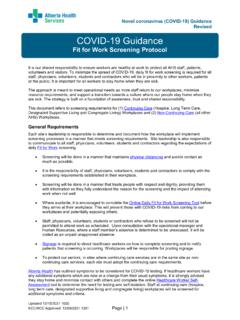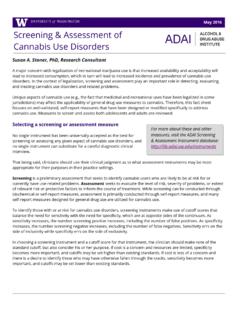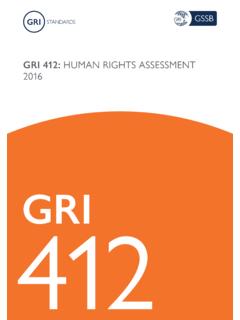Transcription of Getting Paid for Screening and Assessment Services
1 November/December 2017 | | FAMILY PRACTICE MANAGEMENT | 25 CMEIf you re not coding and billing for these Services , you might be leaving money on the Paid for Screening and Assessment ServicesCindy Hughes, CPC, CFPC Recent changes to CPT codes for structured screenings and brief assessments have led some payers to expand coverage for these Services . If you are not billing for these Services , you may be losing out on valuable revenue. Quality initiatives may include incentives for performing and reporting rec-ommended screenings and assessments, which provides an additional reason to familiarize yourself with these codes. In this article, we will review the documentation and billing requirements necessary for Getting paid. Correct coding and documentationFour codes are used to report structured Screening and assessments: 96110, Developmental Screening ( , developmen-tal milestone survey, speech and language delay screen ), with scoring and documentation, per standardized instrument, 96127, Brief emotional/behavioral Assessment ( , depression inventory, attention-deficit/hyperactivity disorder scale), with scoring and documentation, per standardized instrument, 96160, Administration of patient-focused health risk Assessment instrument ( , health hazard appraisal) with scoring and documentation, per standardized instrument, 96161, Administration of caregiver-focused health risk Assessment instrument ( , depression inventory) for the benefit of the patient, with scoring and documen-tation, per standardized instrument.
2 Codes 96110, 96160, and 96161 are typically limited to developmental Screening and the health risk assess-ment (HRA). However, code 96127 should be reported About the AuthorCindy Hughes is an independent consulting editor based in El Dorado, Kan., and a contributing editor to Family Practice Management. Author disclosure: no relevant financial affiliations from the Family Practice Management website at Copyright 2017 American Academy of Family Physicians. For the private, noncommercial use of one individual user of the website. All other rights reserved. Contact for copyright questions and/or permission | FAMILY PRACTICE MANAGEMENT | | November/December 2017for both Screening and follow-up of emotional and behavioral health conditions. The purpose of the Screening or assess-ment should guide code selection. To see a description of each code and examples of standardized instruments that may be used for each, see Quick reference: Screening and Assessment codes, page 28.
3 CPT Assistant has described a standardized instrument as a pre-viously validated test that is administered and scored in a consistent or standard manner. Validated structured instruments have been shown through study to provide consistent and reliable results. These codes do not represent physician work . For payment purposes, each screen -ing and Assessment code was valued based on practice expense and professional liability only, which includes the cost of furnishing instru-ments (when applicable) and staff time to administer and/or score an instrument for the physician or other qualified health care profes-sional s review. The physician s interpretation of the score in light of the patient presentation is considered part of the evaluation and man-agement (E/M) service, which would be billed in addition to the Screening or Assessment code. Documentation of a structured screen -ing or Assessment should include the date, patient s name, name and relationship of the informant (when information is provided by someone other than the patient), name of the instrument, score, and name and cre-dentials of the individual administering the instrument.
4 In addition, the physician must document that he or she reviewed the score in the context of the patient presentation and discussed the results with the patient/family as part of the related E/M service. A few payers do indicate that a report (separate from the E/M service documentation) is required. This is based on CPT guidance for central nervous system assessments that states, It is expected that the administration of these tests will generate material that will be formulated into a report. Verify your payers documentation requirements prior to providing these paid for screenings and assessmentsAlthough the fee-for-service payment for Screening and assessments may be small, it can add up to significant income across a patient panel. In addition, most are recommended preventive Services , and some may also be factored into performance ratings and quality initiatives. Screening and Assessment Services should be reported unless a payer s written policy restricts doing so.
5 Because most payment policies are regional rather than national and accessible only through secure provider por-tals, providing a comprehensive list is beyond the scope of this article. It is worth the effort to determine which payers in your area pay for these Services . For example, Aetna clearly encourages and pays for depression Screening reported with code 96127 and ICD-10 code , Encounter for Screening for other disorder. Cigna has a national policy that provides separate coverage of developmental Screening (96110), brief behavioral health Assessment (96127), and depression Screening reported with HCPCS code policies and claims edits are con-stantly changing and should be systematically monitored. Many payers and clearinghouses offer code edit simulators for use in deter-mining whether codes for Services such as screenings and assessments are bundled or separately screeningDevelopmental Screening reported with code 96110 is paid for by 45 state Medicaid pro-grams with rates varying from approximately Payment for Screening and assessments can add up to significant income across a patient panel.
6 Report Screening and Assessment codes unless a pay-er s written policy restricts doing so. When providing these Services , use standardized instru-ments that have been validated. It is worth the effort to determine which payers in your area pay for these 2017 | | FAMILY PRACTICE MANAGEMENT | 27$5 to $ Many private insurers also pro-vide preventive benefits for code 96110 for developmental Screening at nine months, 18 months, and 30 months, and autism Screening at 18 months and 24 months in addition to the recommended preventive medicine E/M Services ( , well-child visits). Developmental surveillance without use of a structured screen -ing instrument is included in the preventive medicine service and not separately reported. Most payers allow two units ( , instru-ments) per date of service for code Screening performed at the time of a well-child exam is reported with ICD-10 codes , Encounter for rou-tine child health examination with abnormal findings, or , Encounter for routine child health examination without abnormal findings.
7 If developmental Screening is pro-vided at an encounter other than a well-child exam, report code , Encounter for Screening for certain developmental disorders in children. Watch for payer policies that may require reporting of both codes ( or and ) even though ICD-10 indicates separate codes are not : An 18-month-old established patient is seen for a well-child exam. Staff administer and score two structured Screening instruments for development and autism. The physician completes the age- and gender-appro-priate history and exam, including a review of the scores of the Screening instruments, and provides counseling/anticipatory guidance and/or identifies the need for diagnostic test-ing as indicated. The physician reports code 99392 for the preventive service and two units of code 96110 for the administration of the structured Screening instruments. No modifier is necessary because the commercial payer does not bundle 96110 with 99392 and allows two units per date of service as the maximum allow-able for code 96110.
8 Diagnosis code , Encounter for routine child health examina-tion without abnormal findings, is linked to each service reported as this code includes an encounter for developmental and behavioral health assessmentsDepression Screening , reported with 96127, is typically a covered preventive service for ado-lescents age 12 to 18 and is a quality measure in many pediatric quality initiatives. This code may also be reported for depression Screening in adult patients other than Medicare benefi-ciaries. For instance, Aetna has a long-standing policy to cover depression Screening in primary care when the service is performed using the Patient Health Questionnaire-9 (PHQ-9) tool and is reported with code annual depression Screening of up to 15 minutes is covered for Medicare beneficiaries in primary care settings that have staff-assisted depression care supports in place to assure accurate diagnosis, effective treatment, and follow-up. (For more information, see screen -ing Your Adult Patients for Depression, FPM, March/April 2016, ) Code G0444 should be reported to Medicare Part B admin-istrative contractors for this purpose instead of code 96127, and the time spent on Screening and discussing results and recommendations should be documented.
9 Depression Screening is not separately reported in conjunction with a Medicare initial preventive physical examina-tion (IPPE, Welcome to Medicare exam) or an initial Medicare annual wellness visit (AWV).Payer guidance for reporting postpartum depression Screening also varies. Many Medic-aid plans have adopted code 96161 for screen -ing for postpartum depression at well-baby visits (some may allow up to six screenings before the child is 13 months old).Code 96127 is also applicable to assess-ments for conditions such as anxiety, attention-deficit disorders, and generalized psychosocial symptoms ( , pediatric symp-tom checklist). Report ICD-10 code , Encounter for Screening for other disorder, in conjunction with depression Screening ser-vices. Use of structured instruments for assess-ing attention deficit should be linked to the ICD-10 code for the diagnosis or symptoms that prompted the A: An adult established patient with opioid addiction, currently in remis-sion, is seen for a routine physical examina-tion.
10 Clinical staff administer and score a structured Screening instrument for depres-sion with positive results. The physician provides the age- and gender-appropriate history and examination and briefly discusses the positive depression Screening result with the patient. The patient expresses a feeling of hopelessness related to relationships lost Depression screen -ing, reported with 96127, is typically a covered preventive service for adoles-cents age 12 to 18. Depression screen -ing is not sepa-rately reported in conjunction with a Welcome to Medicare exam or an initial Medicare annual wellness visit. Many Medicare plans have adopted code 96161 for Screening for post-partum depression at well-baby CODES28 | FAMILY PRACTICE MANAGEMENT | | November/December 2017during opioid use and sexuality issues. The patient is reluctant to take any medication due to her addiction. The physician recom-mends a consultation with a psychologist for management of moderate major depression, and a staff member arranges the appoint-ment for later in the week.















